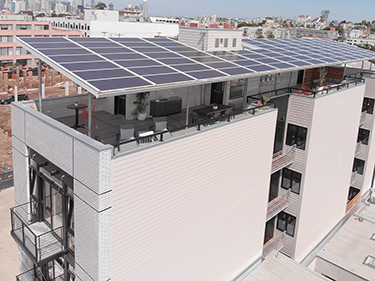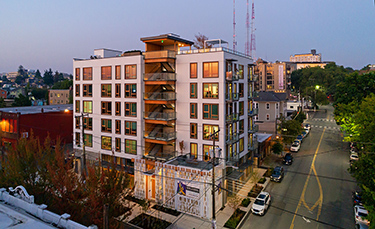|
Subscribe / Renew |
|
|
Contact Us |
|
| ► Subscribe to our Free Weekly Newsletter | |
| home | Welcome, sign in or click here to subscribe. | login |
Real Estate
| |
 |
August 25, 2022
Finding the path to zero with resilient urban design
Phius

Klingenberg
|
Over the past decade, the Phius passive building standard and design methodology have proven to be an effective path to zero with clear benefits for developers, designers, builders and inhabitants. A clear business case for Phius methods has been made to developers — it can be done and it works.
Multifamily Phius projects are successfully and cost-effectively being implemented nationwide, forming small neighborhoods of which urban planners and climate justice activists have taken notice. Even more benefits begin to emerge if the concept is applied on a larger scale such as a city block.
An urban landscape centered on passive principles is not only more sustainable and a better place to live, but also more resilient and adaptable as a system. If organized into island-able microgrids, it can react much more effectively to an unforeseen grid outage due to an extreme weather event and insulate its inhabitants from unpredictable energy price spikes.
On a larger scale, benefits of the new renewable distributed energy grid are coming into focus. It is the best baseline for buildings to become an integral part of the infrastructure for renewable energy delivery.
The benefits for a community certified and organized as a microgrid and designed with Phius standards are substantial.
Of course, the benefits on a per-building basis are most obvious: significantly improved quality of construction, indoor air quality, health, comfort and generally improved quality of life as a result. But just as important are building durability, safety, and low maintenance costs, all resulting in peace of mind. These buildings are resilient against outages even before solar and microgrids are added because they can coast through power outages during extreme weather/climate events and maintain habitability — that is true peace of mind.
An even higher level of resiliency and adaptability can be attained if a group of zero-energy buildings organizes into a microgrid, adds its own PV production and batteries, and shares those on a community level. Then, it can produce enough energy to meet its community’s entire (extremely low) energy consumption and might still have some left over to export.
Such passive building design on a block level is also inherently grid-friendly by significantly reducing loads and the need for costly power plants. This helps city managers meet the energy demand.
With this type of design, the buildings and city blocks become capable of demand response and interactivity benefiting the wider grid. One could argue this also benefits national security by “hardening” the grid for greater reliability.
As communities look to decarbonize building operations in an effort to adapt to and mitigate against future extreme climate events, passive zero buildings provide a solution for urban planners to do just that. Phius buildings are optimized for low energy consumption and allow the design team to quantify how much energy will be needed and design the (much smaller) energy generation system accordingly. This would be impossible to do for a city block of non-Phius buildings.
Passive buildings also come pre-electrified. Added solar PV, batteries and microgrid technology set these city blocks up perfectly for electric vehicles.
Additional benefits provided through the rigorous Phius certification process include reliable third-party verification of design, construction and performance. The quality assurance required for Phius certification serves as a valuable risk management tool.
Many states are recognizing the larger-scale quality-of-life benefits of passive buildings as well as the positive impact they can have on the energy infrastructure. The number of multifamily units certified to the Phius standard has been accelerating nationwide. Phius has certified or pre-certified more than 8.6 million square feet including nearly 300 single-family dwellings and more than 200 multifamily projects.
Massachusetts is the first state to recognize those benefits on a statewide basis. It has proposed to include Phius standards performance levels in its new zero energy stretch code for all new multifamily construction. New York State is likely going to follow suit.
And that is just the beginning. Urban passive building developments following this mold are proven to be safer and healthier for inhabitants while adding a level of grid stabilization that is impossible with lesser-built buildings. These buildings are the future of urban development, and it’s a matter of when — not if — we get there.
Katrin Klingenberg has developed and delivered building-science-based training on how to design and build energy-efficient and zero-energy buildings.
Other Stories:
- Catalysts for change: buildings that reinvigorate our cities
- Small towns and sustainable growth
- Legislation provides new opportunities for energy conservation projects
- Creativity is hallmark for 555 Tower
- Using GIS to support equitable community development
- Real estate companies need to think creatively
- How to create a compelling destination
- Sammamish’s new Town Center will build community




